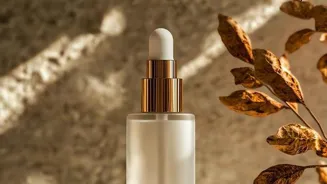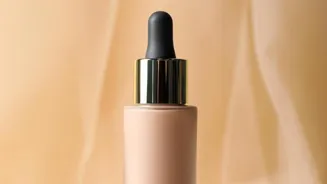Unveil Your Skin's Secrets: A Guide to Tailoring Your Skincare Routine. Discover your skin type & perfect routine
Knowing your skin type is the secret ingredient to getting that glow everyone craves. Forget
blindly following trends or grabbing any fancy cream off the shelf!

Understanding whether you have oily, dry, normal, combination, or sensitive skin is the first step to building a skincare routine that actually works for you. It's like getting a tailor-made outfit for your face – a perfect fit that brings out the best.
So, ditch the guesswork, and let's dive into how to figure out your skin type, and then customize your skincare to keep your skin happy and healthy.
Understanding different skin types for better care
First things first, let’s understand the main skin types that exist. Oily skin is usually recognized with an all-over sheen, often with enlarged pores and possibility of acne. Dry skin, on the other hand, feel tight and sometimes flaky. Normal skin is balanced and doesn't usually have many issues.

Combination skin has both oily and dry areas, usually an oily T-zone and dry cheeks. And finally, sensitive skin reacts easily and needs special care. Finding your skin type will help you better care for yourself.
Identify skin type with bare-faced observation method
One of the simplest ways to identify your skin type is the "bare-faced observation" method. This method requires you to cleanse your face with a gentle cleanser and then leave it bare for about an hour. Avoid applying any skincare products during this time.
During the hour, observe how your skin feels and looks. Is your face shiny all over? Is it starting to feel tight or itchy? Or is it perfectly comfortable and balanced? You should use very gentle cleansers that are natural.
This way you can see what the skin really looks like without any product interference.
Determine your skin type for the right skincare
After the hour has passed, gently blot your face with a blotting paper or tissue, paying close attention to different areas like your forehead, nose, and cheeks. If the blotting paper comes away completely dry, you likely have dry skin.
If it picks up a significant amount of oil from all areas, especially your forehead, nose, and chin (the T-zone), you probably have oily skin. If the blotting paper only picks up oil from your T-zone, you're likely rocking combination skin – oily in some areas, and normal or dry in others.
If your skin feels comfortable and balanced, with minimal oil or dryness, congratulations, you probably have normal skin. If you see signs of redness, irritation, or experience itching or burning after cleansing, you most likely have sensitive skin.
This careful observation is key to tailoring the right skincare routine.
Manage oily skin with oil-free products, exfoliate gently, hydrate
If you've identified your skin as oily, your goal is to manage excess oil production without stripping your skin of essential moisture. Look for lightweight, oil-free cleansers and moisturizers that won't clog pores and lead to breakouts.
Gel-based or foaming cleansers work well for oily skin, effectively removing dirt and excess sebum. When it comes to moisturizers, opt for water-based or gel-based formulas that are non-comedogenic (meaning they won't block pores). Avoid heavy creams and oil-based products.
Serums with ingredients like niacinamide and salicylic acid can regulate oil production and help clear up any existing acne and blemishes.
Regularly exfoliate your skin using a gentle scrub or a chemical exfoliant like AHA or BHA to remove dead skin cells that can contribute to clogged pores and breakouts. Don't over-exfoliate, as this can cause irritation and even more oil production!
Remember, even oily skin needs hydration, so don't skip moisturizer.
Hydrate dry skin with gentle cleansers, rich moisturizers, oils, and gentle exfoliation
For those with dry skin, the name of the game is intense hydration and moisture retention. Look for creamy, hydrating cleansers that won't strip your skin of its natural oils. Avoid harsh soaps and cleansers with sulfates, as these can further dry out your skin.

Invest in a rich, emollient moisturizer packed with ingredients like hyaluronic acid, glycerin, and ceramides, which help to attract and retain moisture in the skin. Apply moisturizer immediately after cleansing and patting your skin dry to lock in as much hydration as possible.
Consider adding a facial oil to your routine for an extra boost of moisture. Look for oils like Argan oil, Rosehip oil, or Jojoba oil, which are nourishing and can help to soothe dry, irritated skin.
Exfoliate gently once or twice a week to remove dead skin cells and allow your moisturizer to penetrate more effectively. Avoid long, hot showers, as these can strip your skin of its natural oils.
Balancing act for combination skin: target oily areas, hydrate dry spots with tailored routine
Combination skin requires a balancing act, targeting oily areas while hydrating dry areas. Use a gentle, pH-balanced cleanser that won't over-dry or irritate your skin.
You might consider using different cleansers for different areas – a foaming cleanser for your T-zone and a creamy cleanser for your cheeks. Apply a lightweight, non-comedogenic moisturizer all over your face and spot treat dry areas with a richer cream or balm.
Consider using a toner with ingredients like witch hazel or salicylic acid on your T-zone to help control oil production. Multi-masking can be a great way to address the different needs of your skin – apply a clay mask to your T-zone to absorb excess oil and a hydrating mask to your cheeks.
Be mindful of seasonal changes, as your skin's needs may change depending on the weather.
Skincare routine for normal skin: keep it simple and balanced
If you're blessed with normal skin, count your blessings! Your skincare routine can be relatively simple. Use a gentle, all-purpose cleanser to remove dirt and makeup. Choose a lightweight, hydrating moisturizer to maintain your skin's natural balance.
A simple serum with antioxidants like Vitamin C can help protect your skin from environmental damage. Exfoliate once or twice a week to remove dead skin cells and keep your skin looking bright and healthy. The key is to maintain your skin's natural equilibrium and prevent any potential problems.
Sensitive skin care: avoid irritants, use gentle products, consult dermatologist for issues
Sensitive skin needs extra gentle care and products free from harsh ingredients. Avoid fragrances, dyes, and alcohol, common irritants that can trigger reactions. Look for cleansers and moisturizers specifically formulated for sensitive skin, often labeled as "hypoallergenic" or "fragrance-free.

" Patch test new products before applying them to your entire face to check for any sensitivity or allergic reactions. Use a mineral sunscreen with zinc oxide or titanium dioxide, as these are less likely to irritate sensitive skin.
Avoid harsh scrubs and chemical exfoliants, and opt for gentle enzymatic exfoliants instead. Above all, be patient and observant, as it may take some trial and error to find the right products for your sensitive skin. Always consult a dermatologist if you have persistent skin issues.
Identify skin type for tailored skincare routine
Once you have diligently identified the skin type that you have, it will become easy to tailor it with ingredients and products. It is important to be realistic and consistent with whatever regime you chose to follow.
After proper observation only can one determine what their skin need are and products can accordingly be found.
AI Generated Content. Glance/InMobi shall have no liability for the content









